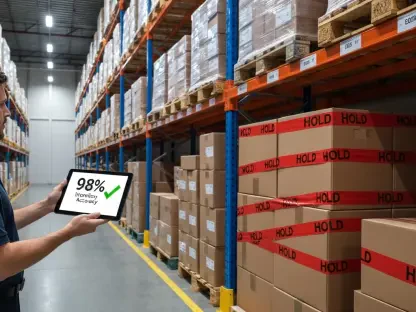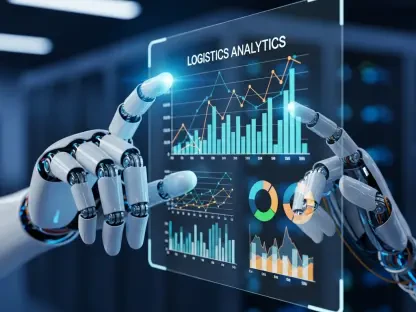In the rapidly evolving logistics sector, last-mile delivery remains one of the most challenging and costly components of the supply chain. According to CapGemini Research, last-mile delivery costs account for approximately 41% of overall supply chain expenses. This financial pressure has spurred logistics carriers to seek innovative solutions to make the last mile more efficient and cost-effective. By 2025, artificial intelligence (AI) is expected to play a crucial role in transforming last-mile delivery, making it faster, smarter, and sustainable. The trends shaping this transformation include route optimization, autonomous delivery vehicles, real-time tracking, smart demand forecasting, improved customer experiences, and sustainability.
Route Optimization
Route optimization involves finding the most efficient way to travel from one location to another while considering various factors such as distance, time, and cost. By using advanced algorithms and technology, businesses can improve their logistics and reduce expenses, ultimately enhancing customer satisfaction and operational efficiency. In many industries, route optimization has become essential for maintaining competitiveness and meeting the growing demands of consumers.
Dynamic Route Adjustments
One of the most significant applications of AI in last-mile logistics is route optimization. Historically, routes were planned based on static traffic conditions, driver intuition, and heuristic-based scheduling. However, with increasing traffic congestion and rising consumer expectations, these traditional methods fall short in addressing real-time changes such as traffic accidents, road closures, and weather variations. AI-powered route optimization enables dynamic adjustments to these factors, improving delivery efficiency. AI algorithms can analyze data from various sources, including live traffic feeds, weather reports, and historical delivery data, to predict the most efficient routes. This real-time decision-making capability helps reduce delivery times, fuel consumption, and operational costs for logistics companies.
The integration of AI-based route optimization tools allows for intelligent and adaptive route planning that can respond to unexpected disruptions. When an unforeseen event like a traffic accident or severe weather occurs, these systems can automatically reroute the driver to avoid delays. This dynamic aspect of AI ensures that delivery schedules remain on track, enhancing customer satisfaction by minimizing late deliveries. Moreover, AI-driven route optimization can predict future traffic patterns based on historical trends, allowing for preemptive adjustments to routes before issues even arise.
Multi-Modal Transport Integration
E-commerce giants and medium-sized logistics companies are gradually adopting AI-based navigation systems, allowing drivers to navigate congested urban areas more effectively and deliver parcels faster. Additionally, route optimization now incorporates multiple modes of transport, such as vans, bicycles, and pedestrian couriers, ensuring each parcel is delivered via the most suitable method. This multi-modal approach, enhanced by AI, reduces traffic congestion, carbon footprint, and overall transportation costs. For instance, in densely populated urban areas, the use of bicycle couriers can be more efficient than traditional delivery vans, especially during peak traffic hours. AI systems can determine the best combination of transport modes based on factors like parcel size, delivery distance, and current traffic conditions.
Adopting a multi-modal transport strategy can significantly improve the flexibility and resilience of last-mile delivery operations. By leveraging AI to orchestrate the seamless transfer of parcels between different transport modes, logistics companies can optimize load balancing and resource allocation. This adaptability is particularly valuable in complex urban environments where traffic patterns can be unpredictable, and delivery routes might require frequent adjustments. Furthermore, the diversification of transport modes helps mitigate risks associated with relying on a single delivery method, such as vehicle breakdowns or regulatory restrictions on certain types of vehicles in specific areas.
The Evolution of Autonomous Delivery Vehicles
The development of autonomous delivery vehicles has seen significant advancements over the past decade, driven by innovations in artificial intelligence, sensor technology, and machine learning. These vehicles promise to revolutionize logistics by increasing efficiency, reducing labor costs, and minimizing human error. Key players in the industry, including tech giants and automotive manufacturers, are investing heavily in research and development to perfect this technology.
AI-Based Drones and Robots
The integration of autonomous technology in last-mile delivery is another trend driven by AI. AI-based drones, robots, and self-driving cars are becoming more prevalent. Companies like Walmart and Amazon have already experimented with drones to deliver small packages within 30 minutes. Ground-based robots and driverless vans, which can operate on sidewalks or quiet streets, are also being tested by various startups and established logistics companies. These autonomous delivery solutions are equipped with advanced sensors, cameras, and AI algorithms that enable them to navigate through complex environments, avoid obstacles, and make real-time decisions to ensure safe and efficient delivery.
AI-based drones and ground robots offer unique advantages for last-mile delivery, particularly in areas with challenging terrain or limited road access. Drones can bypass traffic congestion by taking to the skies, making them ideal for delivering small packages and urgent medical supplies. Ground robots, on the other hand, can handle larger parcels and navigate pedestrian pathways or narrow streets that traditional delivery vehicles might have difficulty accessing. As AI technology continues to evolve, the capabilities of these autonomous systems are expected to improve, leading to more reliable and widespread deployment in urban and rural areas alike.
Advantages of Autonomous Solutions
Autonomous delivery solutions offer several advantages, including round-the-clock operation and the ability to avoid traffic congestion by using off-peak hours for deliveries. As AI technology evolves, these systems will become better at understanding and avoiding obstacles, making large-scale deployment more feasible. By 2025, it is expected that more robotic systems will be delivering goods in urban areas. The 24/7 operational capability of autonomous delivery vehicles can significantly enhance delivery speed and efficiency, allowing logistics companies to meet the growing demand for fast and reliable service. Furthermore, the use of AI allows these systems to continuously learn and adapt to changing environments, improving their performance over time.
The adoption of autonomous delivery vehicles also has the potential to reduce labor costs and address driver shortages, a common challenge in the logistics industry. By automating the delivery process, companies can reallocate human resources to focus on more complex tasks that require critical thinking and problem-solving skills. Additionally, autonomous delivery vehicles can be programmed to optimize routes for fuel efficiency and minimal environmental impact, contributing to sustainability goals. As regulatory frameworks evolve to accommodate these emerging technologies, the widespread adoption of AI-driven autonomous delivery solutions is poised to transform the landscape of last-mile logistics.
Real-Time Tracking and Transparency
Enhanced Visibility with AI
Modern consumers expect transparency in the delivery process, wanting to know every detail from warehouse dispatch to doorstep delivery. AI-enhanced real-time tracking solutions provide visibility by collecting and analyzing extensive location and condition data. AI-driven sensors and Internet of Things (IoT) devices enable real-time tracking of parameters such as location, temperature, humidity, and tampering. These advanced tracking systems can generate real-time updates and alerts, offering both logistics providers and customers a comprehensive view of the delivery status. This level of visibility is critical for ensuring the safety and integrity of sensitive or perishable goods during transit.
Enhanced visibility with AI also extends to improving inventory management and supply chain coordination. By integrating real-time tracking data with inventory management systems, logistics companies can gain better control over stock levels and order fulfillment processes. This integration reduces the risk of stockouts or excess inventory, leading to more efficient and cost-effective operations. Additionally, AI-powered real-time tracking systems can facilitate proactive problem-solving by identifying potential issues before they escalate, such as unexpected delays or deviations from optimal storage conditions, thereby ensuring that deliveries are completed smoothly and on time.
Customer Alerts and Trust
In an effort to restore confidence in America’s banking system, the US government has provided assurance that customers of the failed Silicon Valley Bank (SVB) will be able to access all of their funds beginning on Monday.
These systems also allow customers to receive alerts about shipment delays or delivery statuses, reducing the number of “Where is my order?” inquiries and enabling swift intervention in case of any issues. This transparency enhances customer trust and satisfaction. Customers can monitor their deliveries in real time through mobile apps or online portals, providing them with a sense of control and reassurance. Immediate notifications regarding potential delays, estimated delivery times, and delivery confirmations help keep customers informed and reduce anxiety associated with waiting for packages.
The ability to provide accurate and timely information to customers is a significant competitive advantage in the logistics industry. By leveraging AI-enhanced real-time tracking solutions, logistics companies can differentiate themselves by offering superior customer service. This transparency not only builds trust but also fosters long-term customer loyalty. Customers who have positive experiences with transparent and reliable delivery services are more likely to return for future purchases and recommend the service to others. In an era where customer expectations are continually rising, the integration of AI to enhance real-time tracking and transparency is essential for meeting and exceeding those expectations.
Smart Demand Forecasting through Predictive Analytics
By leveraging data analysis and machine learning, predictive analytics can significantly enhance the accuracy of demand forecasting. This advanced approach enables businesses to anticipate customer needs and trends more effectively, allowing for better inventory management, cost reduction, and overall improved operational efficiency. Through continuous data monitoring and model adjustments, companies can stay ahead of market shifts and make informed decisions that align with their strategic goals.
Traditional vs. AI Models
AI is improving the accuracy and utility of demand forecasting in the logistics industry. Traditional methods consider factors like seasonal variations, marketing activities, and local events to predict future demand. AI models use order data, inventory levels, and real-time market data to provide more accurate forecasts. By analyzing vast amounts of historical and real-time data, AI algorithms can identify patterns and trends that may not be apparent through conventional methods. This advanced level of analysis helps logistics companies anticipate demand fluctuations and make informed decisions about resource allocation, inventory management, and delivery planning.
The transition from traditional forecasting methods to AI-driven predictive analytics represents a significant shift in the logistics industry. AI models can continuously learn and adapt to changing market conditions, improving their predictive accuracy over time. This capability is particularly valuable in a dynamic and fast-paced industry where demand can fluctuate rapidly due to factors such as economic shifts, unexpected events, or changes in consumer behavior. By leveraging AI for demand forecasting, logistics companies can enhance their operational agility and responsiveness, ensuring that they are well-prepared to meet future demand with precision and efficiency.
Addressing Operational Challenges
Predictive analytics helps address challenges such as driver shortages and inventory management, which can impact last-mile delivery. By optimizing demand forecasting, logistics companies can better plan and allocate resources, ensuring timely deliveries. Accurate demand forecasts enable companies to maintain optimal inventory levels, reducing the risk of stockouts or overstocking. This efficiency not only improves customer satisfaction by ensuring product availability but also helps minimize carrying costs and waste. Additionally, AI-driven demand forecasting can assist in identifying peak demand periods, allowing logistics providers to scale their operations and workforce accordingly.
In addressing driver shortages, predictive analytics can optimize route planning and scheduling to maximize the productivity of available drivers. By load balancing and utilizing AI to predict traffic patterns and delivery windows, logistics companies can streamline their operations and reduce the strain on their workforce. Predictive analytics can also identify areas where additional hiring or training may be necessary, enabling proactive recruitment and talent development strategies. Ultimately, the integration of AI-powered demand forecasting into logistics operations enhances overall efficiency, reduces costs, and supports the sustainable growth of the industry.
Improving Customer Experience through AI
AI-Powered Chatbots
Rising customer service standards are driving the adoption of AI-powered chatbots in logistics. These intelligent personal assistants can handle more than just FAQs; they provide real-time updates on package statuses, suggest delivery rescheduling if recipients are unavailable, and assist with return or reroute requests. AI chatbots can engage with customers through various communication channels, including websites, mobile apps, and social media platforms, offering a seamless and efficient customer service experience. These chatbots are equipped with natural language processing (NLP) capabilities, allowing them to understand and respond to customer inquiries in a human-like manner.
AI-powered chatbots significantly enhance the efficiency of customer service operations by handling a large volume of routine inquiries and tasks. This automation frees up human customer service agents to focus on more complex or sensitive issues that require a personalized touch. By providing instant and accurate responses, chatbots reduce response times and improve overall customer satisfaction. Additionally, AI chatbots can gather and analyze customer feedback, offering valuable insights into recurring issues or areas for improvement. This data-driven approach enables companies to continuously refine their services and address customer needs more effectively.
Enhancing Service Quality
For logistics providers, AI chatbots enhance customer satisfaction by offering immediate support, freeing human customer service agents to handle complex or sensitive issues. Chatbots can address common delivery-related concerns, improving overall service quality. For example, if a customer needs to reschedule a delivery due to an unforeseen event, the AI chatbot can quickly process the request and update the delivery schedule accordingly. Similarly, in case of a return or reroute request, the chatbot can provide clear instructions and facilitate the necessary arrangements, ensuring a smooth and hassle-free experience for the customer.
The use of AI chatbots in logistics also contributes to a more streamlined and cohesive customer service experience. By integrating chatbots with other AI systems such as real-time tracking and demand forecasting, logistics companies can provide customers with comprehensive and accurate information at every touchpoint. This level of integration reduces the likelihood of miscommunication and enhances the overall reliability of the service. As customer expectations continue to evolve, leveraging AI-powered chatbots allows logistics providers to stay ahead of the curve by offering immediate, personalized, and efficient support that meets the demands of modern consumers.
Sustainability Driven by AI
Optimizing Routes for Sustainability
Sustainability has evolved from a corporate slogan to a crucial business strategy, driven by growing global environmental concerns. AI helps optimize delivery routes, reducing carbon footprints and transportation costs. Electric vehicles and AI-powered route planning systems identify charging stations and optimize routes to minimize environmental impact. By incorporating sustainability metrics into route optimization algorithms, AI can ensure that deliveries are not only efficient but also environmentally friendly. For instance, AI can calculate the most energy-efficient routes, taking into account factors such as traffic patterns, road conditions, and vehicle load.
The adoption of AI-driven sustainability measures in logistics supports broader corporate social responsibility (CSR) initiatives. Companies that prioritize sustainability in their operations can enhance their brand reputation and appeal to environmentally conscious consumers. Additionally, optimizing routes for sustainability can lead to significant cost savings by reducing fuel consumption and vehicle wear and tear. The use of electric vehicles further contributes to lower greenhouse gas emissions, aligning with global efforts to combat climate change. As regulatory frameworks and consumer expectations continue to evolve, integrating AI to drive sustainability in last-mile delivery is not only a strategic advantage but also a necessary step towards a more sustainable future.
Efficient Fleet Management
Predictive analytics and coordinated vehicle routing ensure that trucks are loaded to full capacity without overloading, reducing the number of trips required. Efficient fleet management also cuts fuel usage, maintenance costs, and driver hours, improving profitability while promoting sustainability. AI can analyze fleet data to identify patterns of inefficiency or areas for improvement, allowing logistics companies to optimize their fleet operations. For instance, predictive maintenance algorithms can forecast potential vehicle issues before they become critical, enabling timely repairs and reducing downtime.
Efficient fleet management through AI also enhances the overall productivity of logistics operations. By optimizing vehicle routes and schedules, companies can maximize the utilization of their fleet assets, ensuring that each vehicle is operating at its full potential. This level of efficiency not only reduces operational costs but also minimizes the environmental impact of logistics activities. Additionally, AI-driven fleet management can support the transition to greener technologies, such as electric or hybrid vehicles, by providing insights into optimal vehicle usage and charging strategies. As the logistics industry continues to evolve, leveraging AI for efficient and sustainable fleet management is essential for achieving long-term success.
Challenges and the Road Ahead
The journey of incorporating cryptocurrencies into mainstream financial systems is fraught with numerous challenges. As regulatory bodies like the SEC navigate these uncharted waters, they must balance innovation with investor protection. The evolving landscape of digital assets demands a comprehensive regulatory framework that can adapt to rapid technological advancements without stifling growth. Furthermore, international coordination is essential to ensure consistent standards and prevent regulatory arbitrage. The road ahead is complex, but with careful deliberation and collaboration, the potential for cryptocurrencies to revolutionize the financial industry remains promising.
Privacy and Regulatory Concerns
In the fast-changing logistics industry, last-mile delivery stands out as one of the most complex and expensive parts of the supply chain. According to CapGemini Research, last-mile delivery makes up around 41% of total supply chain costs. This significant financial burden has driven logistics providers to find innovative ways to make last-mile delivery more efficient and cost-effective. By 2025, artificial intelligence (AI) is anticipated to significantly impact last-mile delivery, enhancing speed, intelligence, and sustainability.
The trends driving this evolution include route optimization, the use of autonomous delivery vehicles, real-time tracking, smart demand forecasting, and improved customer experiences. Moreover, a strong focus on sustainability marks another key trend in transforming last-mile delivery. These advancements promise to reshape the logistics sector, addressing the complexities and high costs associated with last-mile delivery while also aiming to meet the demands of an increasingly connected and environmentally conscious world.









